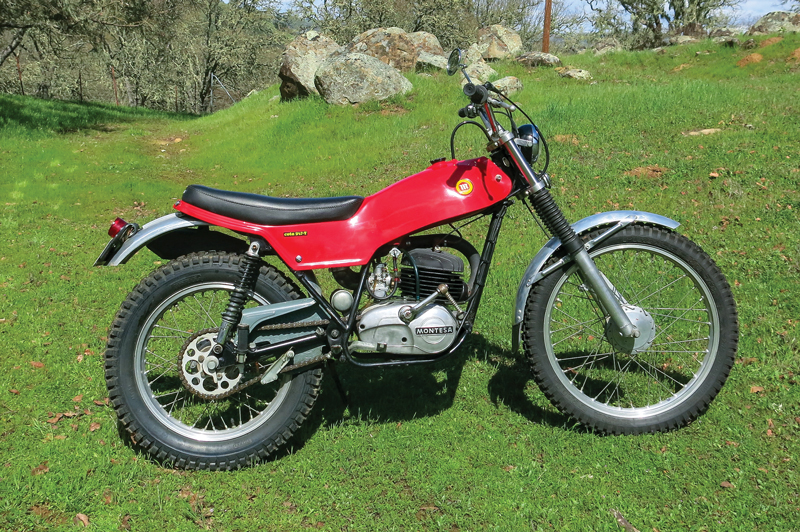
The Spanish Civil War ended in 1939, and then the rest of Europe spun out of control. Spain sensibly decided to stay neutral in World War II. With a limited domestic market, business stagnated. But by 1944, with the end of that conflict in sight, Spaniards started thinking about the future. A couple of like-minded fellows, Pedro Permanyer and Francisco Bulto, met up and decided that providing their countrymen with basic transportation could be profitable. They built a factory in Barcelona and began producing Montesa motorcycles, little two-stroke singles under 125cc, and had great success. But the partners had their differences, and in 1958 Bulto went off on his own to found the Bultaco motorcycle company.
Permanyer persisted, built larger engines, and in 1965 showed the 247cc engine (21 horsepower at 7,000 rpm) in a Scorpion motocrosser. Several years later a mildly detuned version appeared in the Cota trials bike, and in 1968 the Cota won the Spanish Trials Championship. It should be noted that trials competitions were very popular in Europe, less so in the U.S.
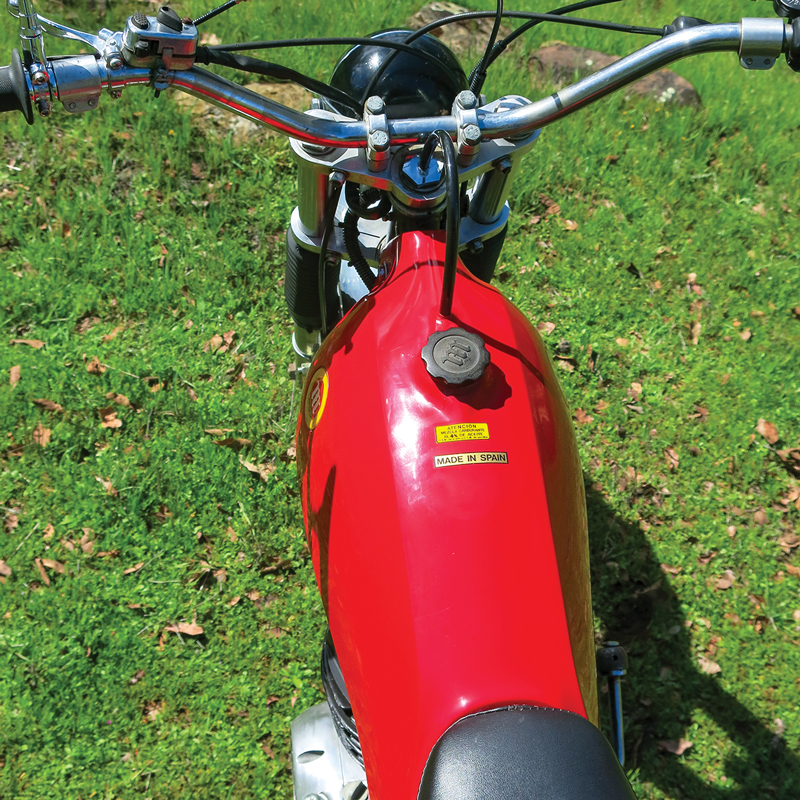 In the early 1970s the Japanese OEMs began modifying some of their competitive 250 dirt models into more civilized trail bikes, or as we might say today, dual-purpose. These had two-up seats, lights, a horn, whatever it took to make them street-legal. Permanyer took note. He had a great 250 engine, seen in motocross, roadracing, enduro and trials versions, so why not turn that trials bike into a trail version for the European street crowd; those countries weren’t quite as fearful of two-stroke emissions as were the Americans. The Cota 247-T (for Trail) was born.
In the early 1970s the Japanese OEMs began modifying some of their competitive 250 dirt models into more civilized trail bikes, or as we might say today, dual-purpose. These had two-up seats, lights, a horn, whatever it took to make them street-legal. Permanyer took note. He had a great 250 engine, seen in motocross, roadracing, enduro and trials versions, so why not turn that trials bike into a trail version for the European street crowd; those countries weren’t quite as fearful of two-stroke emissions as were the Americans. The Cota 247-T (for Trail) was born.
Montesa had about 300 dealers in the U.S., who were doing well with some of the competition bikes. Apparently the importer thought this 247-T could be an added attraction. According to sketchy records the factory produced some 2,300 of them, with very few coming to this country. One reason being that it was expensive compared to the competition.
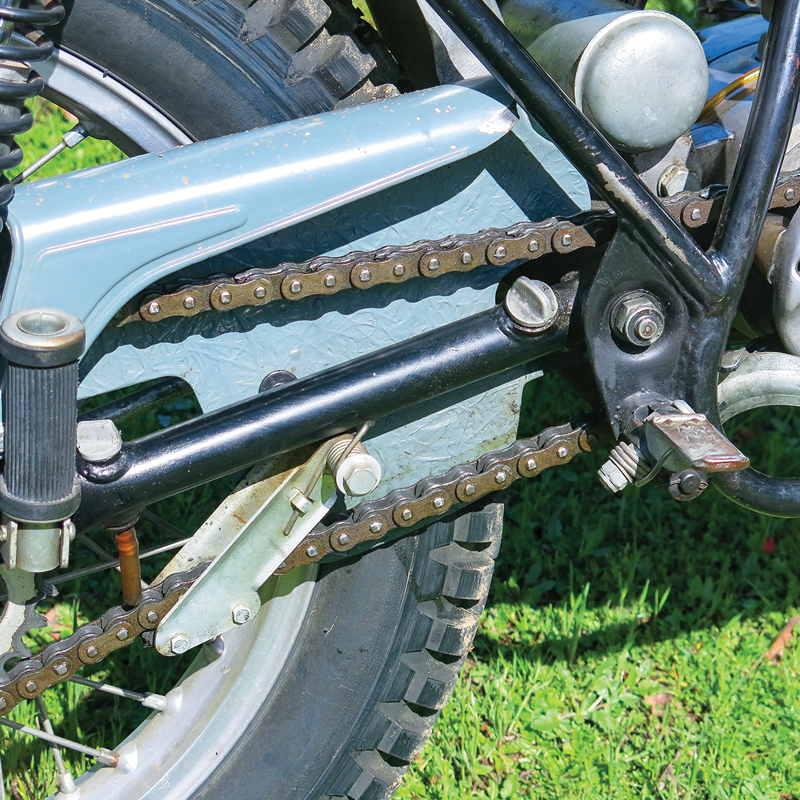 The Owner’s Manual, in Spanish, English and French, begins well: “The MONTESA motorcycle which model is introduced here do (sic) not require an excessive care for maintenance, only a minimum attention is required to ensure a long and perfect serviceable time.” Truth, as the Cota is a delightfully basic machine.
The Owner’s Manual, in Spanish, English and French, begins well: “The MONTESA motorcycle which model is introduced here do (sic) not require an excessive care for maintenance, only a minimum attention is required to ensure a long and perfect serviceable time.” Truth, as the Cota is a delightfully basic machine.
The oversquare piston-port single cylinder has a bore of 72.5mm, stroke, 60mm, with a compression ratio of 10 to 1, generating some 19 horsepower at 6,500 rpm. Ignition is via a flywheel magneto/alternator and coil. The header pipe goes out the left side, high up, with a two-part muffler and spark arrestor. A respectable muffler, too, the two-stroke pop-pop being pleasantly muted.
The air cleaner is under the seat, with a Spanish-made 27mm Amal carburetor carrying fuel into the engine. A previous owner of this bike has replaced the Amal with a Mikuni. Should there be a need to remove the carb, the manual says, “Have in mind that you must shut the entrance of the admission pipe while the carburetor is out, in order to avoid the entrance of odd objects in the interior of the cylinder.”
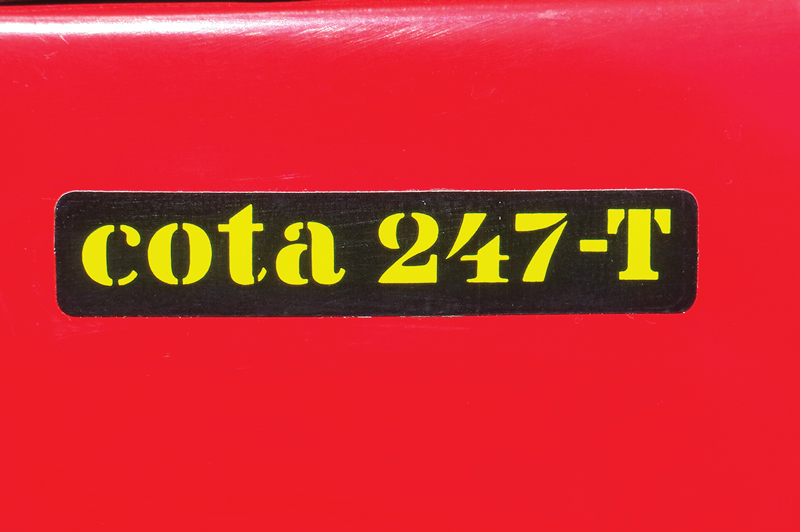 Primary drive is via spur gears, 22 teeth off the crankshaft, 64 teeth on the clutch, which uses “multiple steel discs in oil bath with constant tension springs….” That power goes through a five-speed transmission to a 10-tooth countershaft sprocket and a 40-toother on the back wheel. A very nifty chain-oiler has been built into the right arm of the swingarm, which holds a supply of oil that drips onto the chain just as it enters a tensioning device.
Primary drive is via spur gears, 22 teeth off the crankshaft, 64 teeth on the clutch, which uses “multiple steel discs in oil bath with constant tension springs….” That power goes through a five-speed transmission to a 10-tooth countershaft sprocket and a 40-toother on the back wheel. A very nifty chain-oiler has been built into the right arm of the swingarm, which holds a supply of oil that drips onto the chain just as it enters a tensioning device.
The engine/transmission unit sits in a tubular steel frame, with bolts holding it steady fore, aft and top. A single tube comes down from the reinforced steering head, spreading into a cradle at the front of the crankcase, with a sturdy skid plate built in. A small hole in the skid plate allows access to the drain plug. The rear section, holding the seat and upper shock absorber mounts, is built into the main frame, with a strong pivot point for the swingarm. The shocks on this model have no identification mark, but are probably of Telesco making. The telescoping fork is Montesa-made, with a 29.5-degree rake, 5.6 inches of trail.
A 21-inch wheel at the front wears a 2.75 tire, an 18-incher at the back has a 4.00 tire. Small 110mm single-leading-shoe full-width drum brakes are at both ends. When inspecting the wheels it is advisable “to slightly grease all the whirling points with SAE-40 oil.” A short 51.5 inches lie between the axles.
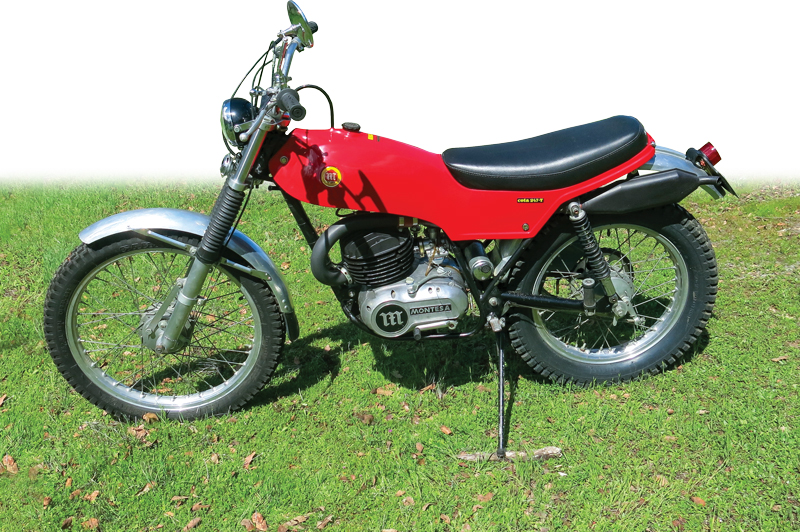 The bike has an attractively slim look, having a narrow 2.14-gallon fiberglass gas tank with wings extending under the long saddle. Fenders are lightweight alloy. A small headlight, horn and taillight make it more or less roadworthy, except there is no battery. The speedometer is missing from the photo model. A modest toolkit fits into a cylindrical container beneath the seat. Dry weight, according to the manual, is 200 pounds…lightweight fun!
The bike has an attractively slim look, having a narrow 2.14-gallon fiberglass gas tank with wings extending under the long saddle. Fenders are lightweight alloy. A small headlight, horn and taillight make it more or less roadworthy, except there is no battery. The speedometer is missing from the photo model. A modest toolkit fits into a cylindrical container beneath the seat. Dry weight, according to the manual, is 200 pounds…lightweight fun!
The last 247cc 247-T was built in 1977, the similarly branded 1978 version having a slightly smaller 237cc engine. That model was then dropped, but the 348-T version kept on for two more years.
Postscript: In 1980 a trials version, the Cota 348, won the World Trials Championship, but Montesa was running into serious financial difficulties. The next year Honda essentially bought the company in order to have better access to the European market, and Montesa Cota models are still being built–albeit with four-stroke engines.

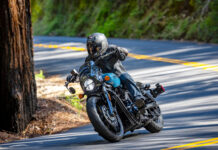






i had 125 trials from that era does anyone know what the model was
It was a Cota 123
I was wondering of the first 500 cota’s made how many came to the usa, I read above, see this is not easy to find out. So do you known anyone with the engine number below 300 of the first 500, this wil give me a base line fore what iam trying to do. thanks for help Lyle
I had a 247t and loved it .it would go anywhere!! It got stollen 2 times I did not get it back the 2nd time 😩. The only thing I did not like about it was it would start without a key and you had to mix the gas and oil. I understand an oil tank and a pump would add more weight and that would be bad for a trials bike.